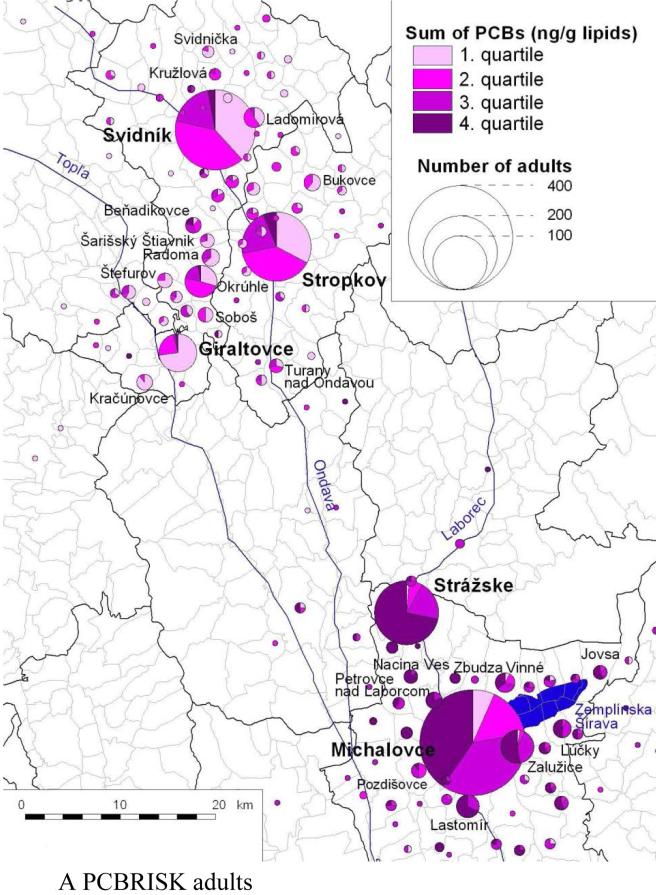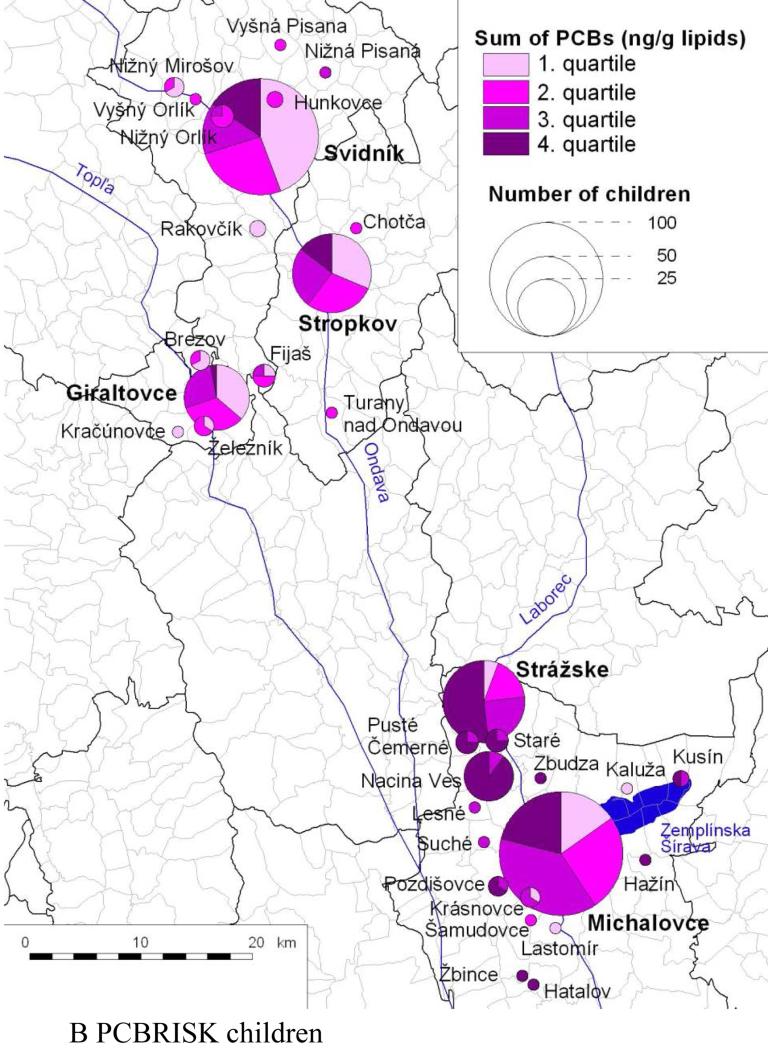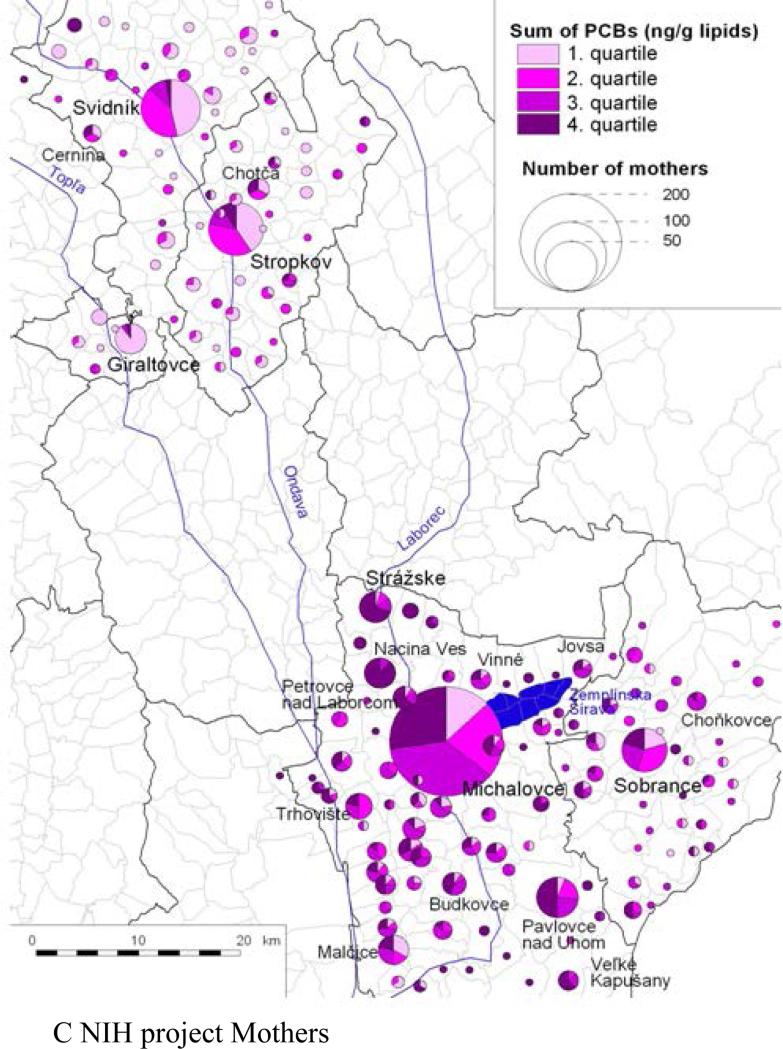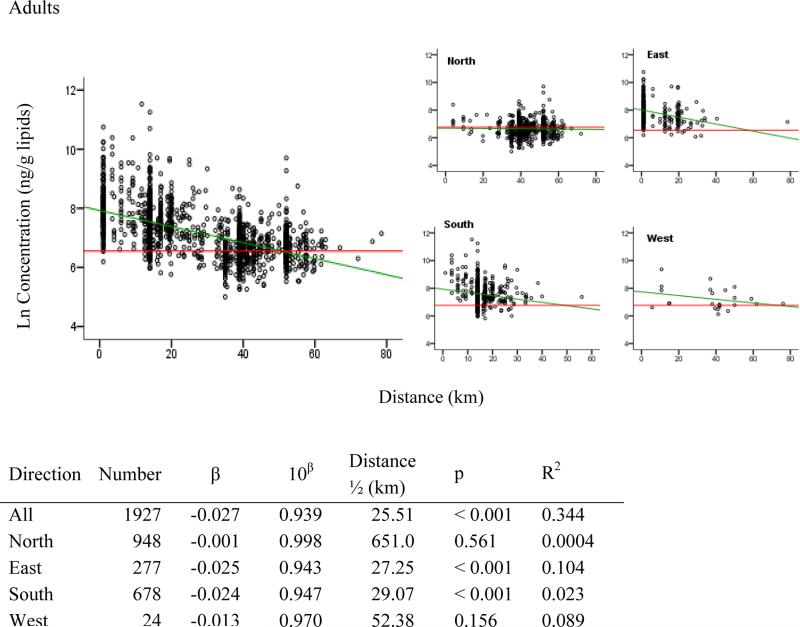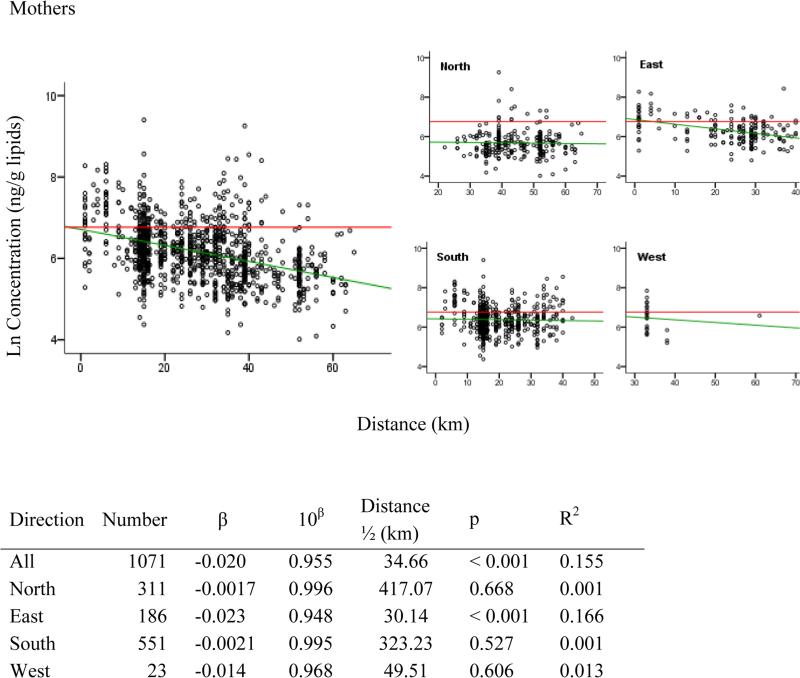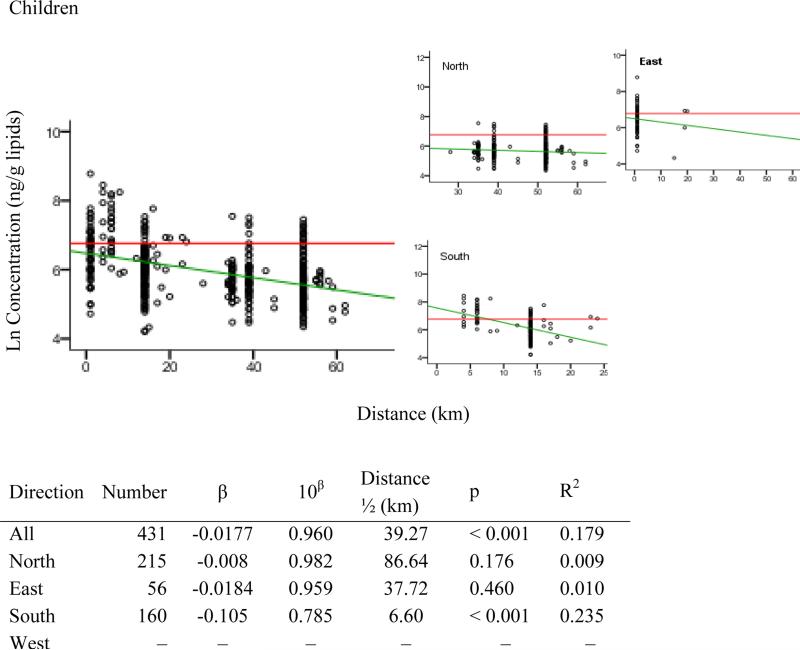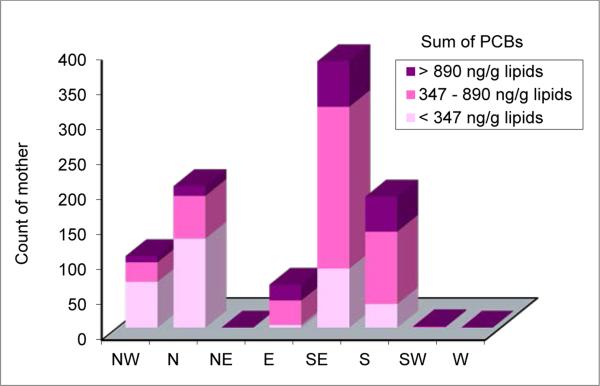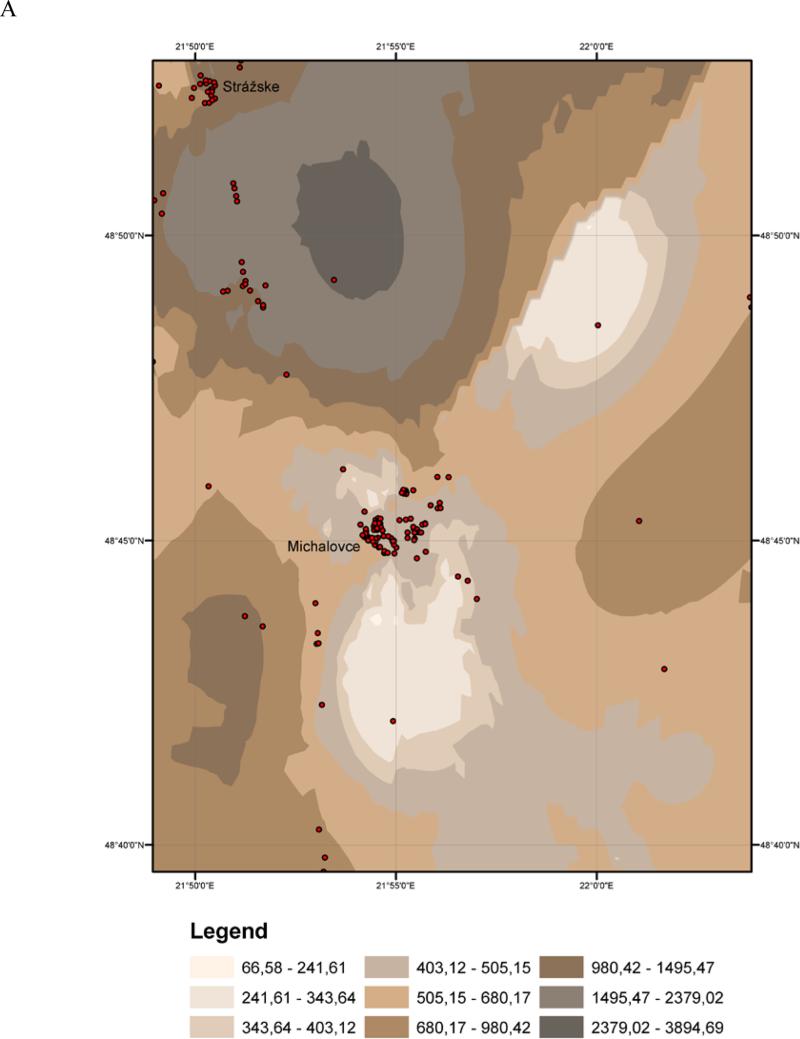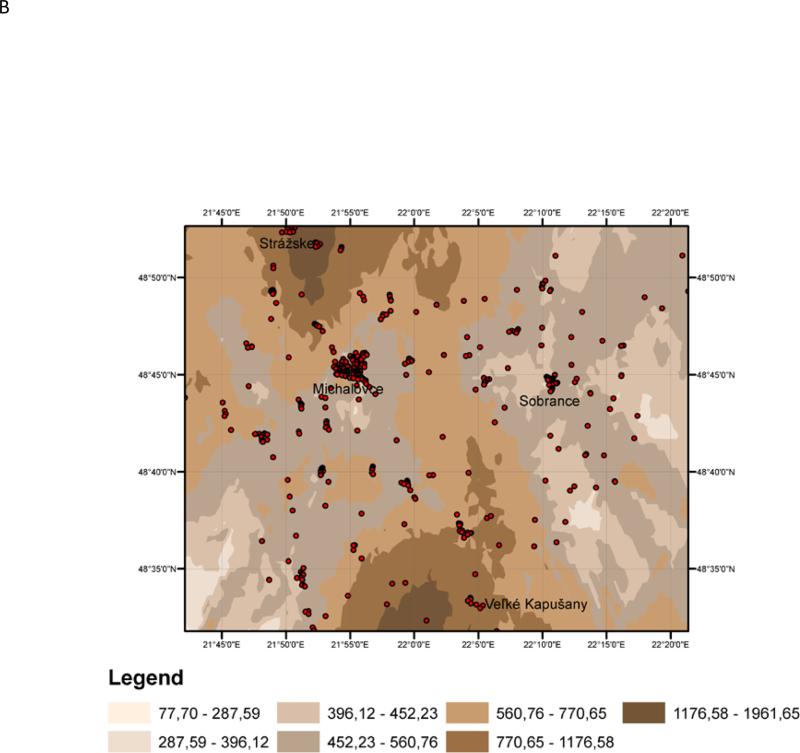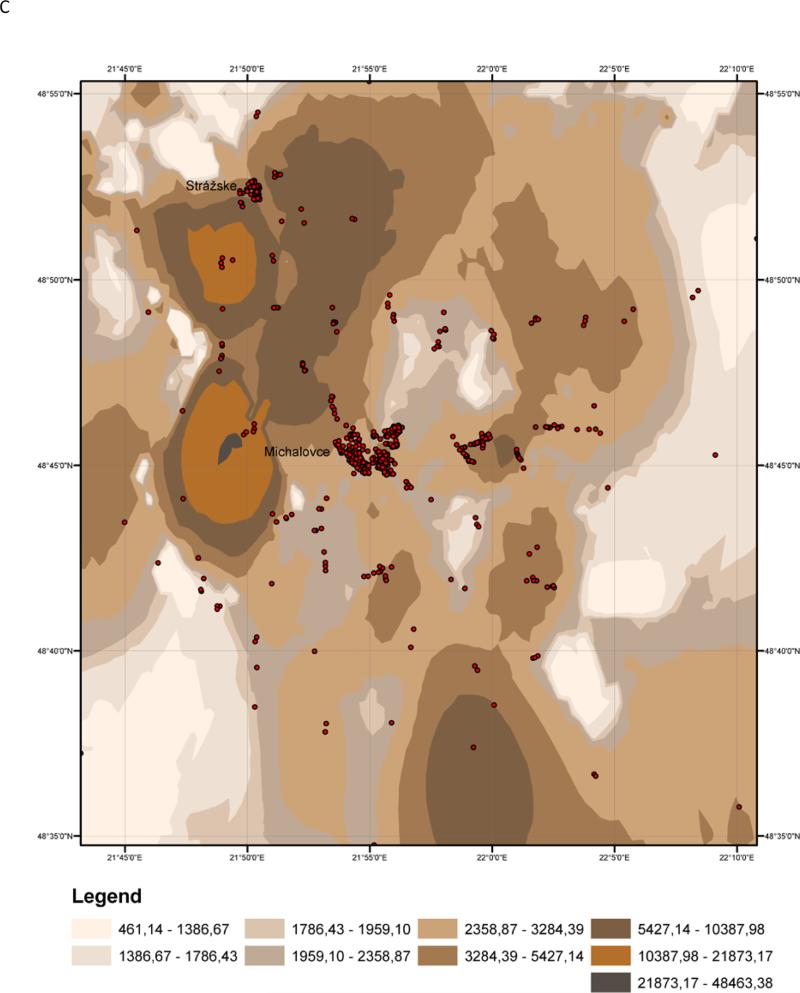Abstract
We evaluated concentrations of 15 PCB congeners in blood serum of 2,047 adults, 431 8-9-years old children and 1,134 mother-child pairs born in 2001-2003. These subjects were long-standing residents living up to 70 km (to the north) and up to 50 km (to the south) of the former Chemko Strážske PCB production facility in the Michalovce district of Slovakia. We plotted serum concentration against distance from the plant both with and without consideration of the direction of their homes from the site. The decrease in exposure with distance could be described by an exponential function which was dependent on direction and climatic parameters. By kriging we created maps depicting predicted isoconcentration contours for sex- and age-adjusted serum concentration of ΣPCBs for the same group of children, adults and mothers. The principle of our risk analysis was to relate serum concentration data, reflecting PCB body burden, using the critical concentrations established by the French Agency for Food, Environmental and Occupational Health & Safety (ANSES 2010) as thresholds below which the probability of effects on health is regarded as negligible. We conclude that 10 years ago around 200,000 residents were at risk in this densely populated area. Exposure has since decreased but the mechanism for this has not yet been studied.
Keywords: Polychlorinated biphenyls, PCBs, Contaminated site, POPs, human biomonitoring, risk assessment, geographic information system, GIS
Introduction
The production of persistent organic pollutants (POPs) has resulted in global contamination of the environment, wildlife and humans (US EPA 2009). Contamination of production sites and from related landfills has been documented for a range of POPs including hexachlorocyclohexane (HCH), polychlorinated biphenyls (PCB) and perfluorooctanesulfonic acid (PFOS) (Amirova and Weber 2015; Jit et al. 2011; Oliaei et al 2013; Torres et al. 2013a; Torres et al 2013b; Vijgen et al. 2011; Weber et al. 2008; Weber and Varbelow 2013). The associated impacts on neighbouring populations have also been documented for some sites (Amirova and Weber 2014; Pavuk et al. 2014; Lam et al. 2013; Humblet et al. 2010; Oliaei et al. 2013; Burns et al. 2009). The wider spatial contamination around these sites has not previously been assessed in relation to human exposure.
The production of PCBs has been established as a major source of environmental contamination in Slovakia (Kocan et al. 1994). The Chemko factory was a PCB production site located near the city of Strážske in the Michalovce district of eastern Slovakia. Between 1959 and 1984 this facility produced around 21,482 t of PCB formulations with the trade names Delor, Delotherm and Hydelor (Kocan et al. 2001). The factory also generated an estimated 1,600 t of PCB wastes, mainly distillation residues containing highly chlorinated biphenyls and terphenyls, as well as polychlorinated dibenzofurans (PCDFs). A large proportion of this waste was released into the environment - mainly via an open effluent canal discharging into the Laborec river and the Zemplínska Šírava lake. Other waste was dumped in Chemko landfills while some distillation residues were mixed with heavy oil and used as fuel in the factory boiler (Kočan et al. 2008).
The scope and extent of environmental contamination and the associated impacts on health have been documented in a series of studies (Kočan et al. 1994; Kočan et al. 2001; Kočan et al. 2008; Jusko et al. 2014; Langer et al. 2014; Hertz-Picciotto et al. 2008; Ghosh et al. 2013; Patayová et al. 2013; Trnovec et al. 2013; Verner et al. 2013; Jusko et al. 2012; Mitra et al. 2012; Trnovec et al. 2011; Horváthová et al. 2011; Dutta et al. 2012; Jusko et al. 2010; Park et al. 2010; Park et al. 2007; Park et al. 2009; Park et al. 2008a; Park et al. 2008b; Sonneborn et al. 2008a; Trnovec et al. 2008; Yu et al. 2007; Park et al. 2007; Linderholm et al. 2007).
In previous studies we examined demographic, behavioural, dietary, and occupational characteristics as predictors of serum PCB concentrations of local residents (Petrik et al. 2006; Patayová et al. 2013; Sonneborn et al. 2008b). We did not, however, systematically analyze the relationship between the place of residence, PCB exposure of residents and the size of the area impacted by PCBs. The aim of this paper is to fill this knowledge gap.
Materials and methods
The source data, along with details of sampling and measurement, are included in the following research projects:
Evaluating human health risk from low-dose and long-term PCB exposure, PCBRISK, EU 5FP project, QLK4-2000-00488 PCBRISK, years 2001-2005. In brief, we examined 2,478 participants (2,047 adults, 50.7% females and 49.3% males, and 431 children between 8-9 years old) living in a PCB-polluted area (districts Svidník, Stropkov and Michalovce). Adults were recruited with the assistance of primary health care physicians by random selection from an alphabetical list of their patients. Children were recruited through local elementary schools. Blood samples of all participants were analyzed for PCBs and organochlorine pesticides. The inclusion criterion for adult subjects was long-term permanent residence in the study area. Subjects were not excluded from the study if suffering from mild chronic controlled illness (e.g. rheumatism, hypertension, diabetes, thyroid disorders, non-morbid obesity, allergy, etc.). Children's mothers should have permanently lived in the respective area for at least 5 years before the child's birth and children had to be delivered and be living in the study area.
Early Childhood Development and PCB exposure in Slovakia, US NIH project # R01-CA96525, years 2003-2006. The study subjects and study protocol has been described in detail (Hertz-Picciotto et al. 2003). Briefly, participants were recruited from two districts: Michalovce with high PCB contamination in the environment from a chemical manufacturing plant (n=812), and Stropkov/Svidnik located 66 km to the northwest, having lower environmental levels of PCBs (n=322). Mothers were enrolled at the time they came to the hospital for delivery. The protocol excluded (1) mothers with more than four previous births, (2) mothers less than 18 years of age, (3) mothers who had resided fewer than 5 years in their district, and (4) mothers with a major illness during pregnancy. Maternal blood was collected at delivery for analysis of PCBs.
Using GIS for analysis of PCB contamination in East Slovakia, 2005/44-SZU-22, funded by Ministry of Health of the Slovak Republic, years 2005-2008.
Serum specimens were collected in projects 1 and 2 and concentrations of 15 PCB congeners (IUPAC No. 28, 52, 101, 123, 118, 114, 153, 105, 138, 167, 156, 157, 180, 170 and 189) were determined as described elsewhere (Kocan et al. 2004; Conka et al. 2005). The sum of the 15 individual PCB congeners analyzed represents ΣPCBs. All analytical measurements were carried out at the National Reference Centre for Dioxins and Related Compounds (Department of Toxic Organic Pollutants, Slovak Medical University), which has been certified by the Slovak National Accreditation Service (ISO/IEC 17 025:2005, certification No. S-111) and regularly participates in interlaboratory studies and proficiency tests on dioxins and PCBs in food and feed.
For the values below limits of detection (LOD), we took the LOD value divided by the square root of 2 if PCB congeners had fewer than 20% of samples below the LOD; Otherwise we used LOD values divided by 2. All concentrations reported in this study are serum lipid adjusted. The study protocols were approved by Institutional Review Boards at the University of California, Davis, and the Slovak Medical University. All subjects gave informed consent to their participation in the studies. Data on the place of residence of participating subjects and on PCB exposures were collected by trained nurses and entered into a database management system using Microsoft Access. We used SPSS software, version16.0, (SPSS Inc., Chicago, Il., USA) and ArcGIS (Esri, 380 New York Street, Redlands, CA 92373-8100, USA) for processing the data. We entered the residential address of each participant, along with the latitude and longitude coordinates into the database. We have created isoconcentration maps using ArcGIS. We adjusted the concentrations for adults of the PCBRISK project for age and sex apart from in mothers of the NIH project and children of the PCBRISK project due to the relative homogeneity of the age distribution in those study samples. The respective zones between the neighboring isoconcentration lines were shaded brown with darker shades representing increasing serum ΣPCBs concentration. The optional output variance of prediction raster created contains the kriging variance at each output raster cell. Assuming the kriging errors are normally distributed, there is a 95.5 percent probability that the actual z-value at the cell is the predicted raster value, plus or minus two times the square root of the value in the prediction raster.
Results
Descriptive statistics on serum concentration of ΣPCBs in subjects of the PCBRISK project and the mothers of the US NIH project are described in Table 1, however the data reflect the situation more than 10 years ago. To relate the PCB population exposure to place of residence we used several complementary approaches:
Firstly we split the participants of each project described in section two above into quartiles with regard to ΣPCBs serum concentration. The concentration limits of quartiles together with the geometric means of the ΣPCBs serum concentration of subjects of projects are shown in Table 1. The spatial distribution of exposure of project subjects with regard to place of residence is shown in Fig. 1. The diameter of the pie chart is proportional to number of subjects evaluated and the scale is shown in the inset. The pie slices are proportional to the percentage of the subjects with ΣPCBs serum concentration within the limits of the respective quartile. It can be seen from Fig. 1A, for example, that in the city of Michalovce approximately 400 adults were examined and, of these, more than one quarter but less than one half were in the fourth highest quartile, i.e. their ΣPCBs serum concentration was ≥1,978 ng/g lipids.
Next we plotted the ΣPCBs serum concentrations as a function of distance from the source of pollution regardless of direction of the place of residence from pollution source and in direction of the points of the compass (Fig. 2). We described the decrease of ΣPCBs serum concentration by a monoexponential function and computed the concentration at Distance = 0. The differences between these values for individual project groups reflect mainly differing age (e.g. PCBRISK project older adults vs. NIH project younger mothers). The Distance 1/2 parameter in plots disregarding the direction of the residence from the pollution source, with values of 25.51, 34.66 and 38.51 km for adults, mothers and children, respectively, is similar for the 3 project groups. However we observed differences in the Distance 1/2 parameter when plotting the serum concentrations for the four points of the compass. Next we compared our distribution data with the limits suggested by the European Food Safety Authority (EFSA) and the French Agency for Food, Environmental and Occupational Health & Safety (ANSES 2010). EFSA suggests a value of approximately 1,000 ng total PCB/g of plasma lipids for the entire population (EFSA 2005). ANSES proposed a critical concentration of 700 ng total PCB/g of plasma lipids as a threshold for pregnant women; women of childbearing age; lactating women; and children under three years of age with a maximum limit of 1,800 ng total PCB/g of plasma lipids for the rest of the population (ANSES 2010). We have marked with a horizontal red line the ANSES 700 ng total PCB/g limit in Fig. 2 which shows that 10 years ago the serum concentration of a significant portion of the adult and child populations exceeded the limit. It can also be seen that the highest levels are found in adults living to the south and east of the source of pollution, while the exposures to the north are lower. A smaller percentage of the mothers had PCB levels above the critical concentration of 700 ng total PCB/g of plasma lipids compared to the “adult” group because mothers were, on average, younger than other adults and thus accumulated less PCBs. In both south-north directions the decrease with distance was negligible, however exposures to the south were higher compared to the north. This corresponds with the average wind speeds and directions for the town of Michalovce (Fig. 3). It has to be taken into account for risk assessment that with mothers the blood was sampled at delivery and as a result of the easy transfer of PCBs across the placenta (Lancz et al. 2015) the maternal concentration is a biomarker of prenatal exposure. It follows that children of our cohort born mainly south to source of pollution have been at high prenatal exposure risk compared to other directions. The magnitude of the risk did not decrease substantially within 50 km of the factory.
We then obtained more detailed information on exposure to ΣPCBs in relation to place of residence and applied the following variables from the US NIH project to cluster analysis: ΣPCBs serum concentration in ng/g lipid, the distance between the place of residence and the source of pollution in km and the azimuth in degrees. We divided the mothers into three clusters using divisive hierarchical clustering and concentration limits of ΣPCB 347 and 890 ng/g lipids. Approximately half of the mothers (48.99%) had serum concentrations between 347 and 890 ng/g lipid whilst 33.76% had lower concentrations and 17.25% of mothers had higher levels (Fig. 4).
Table 1.
Data on serum concentration of ΣPCBs (ng/g serum lipids) in subjects of the projects evaluated.
| Quartile of ΣPCBs serum concentration | 1 | 2 | 3 | 4 | |
|---|---|---|---|---|---|
| PCBRISK adults N= 2047 | Limits of quartiles | 124-675 | 675-1065 | 1065-1978 | 1978-101411 |
| Geometric mean ΣPCBs concentration | 504.39 | 869.94 | 1436.7 | 3792.49 | |
| PCBRISK children N= 434 | Limits of quartiles | 66-226 | 226-377 | 377-639 | 639-6495 |
| Geometric mean ΣPCBs concentration | 154.06 | 287.05 | 470.9 | 1177.84 | |
| NIH project mothers N= 1087 | Limits of quartiles | 55-288 | 288-443 | 443-710 | 710-12096 |
| Geometric mean ΣPCBs concentration | 202.93 | 359.3 | 546.9 | 1200.3 | |
Fig. 1.
Spatial distribution of exposure of project subjects with regard to place of residence. The pie charts show the percentage of subjects categorized in a quartile of ΣPCBs serum concentration (Table 1) living in a place of residence. The diameter of the circle of the pie chart is proportional to number of subjects evaluated. A. PCBRISK adults. B. PCBRISK children. C. NIH project mothers. The scale is shown in the inset. The pie slices in the pie charts are proportional to the percentage of the subjects in the site (village or city) with ΣPCBs serum concentration within the limits of the respective quartile.
Fig. 2.
Relationship between lnΣPCBs serum concentration of PCBRISK adults, PCBRISK children and NIH project mothers and distance from the pollution source in km. The parameters of the lines of best fit (green) are shown in the adjacent table. The red horizontal line is the critical concentration suggested by ANSES (more see in text).
Fig. 3.
Prevailing winds in Michalovce, promille in interval ≥0 m/s.
Fig. 4.
Distribution of clusters of mothers with regard to concentration of ΣPCBs in relation to 8 cardinal directions.
The mothers were divided according to the direction from the source and using contingency table chi-square test we compared the ΣPCBs serum concentration of mothers with their place of residence in relation to 8 principal directions. This analysis confirmed the strong relationship between concentration of serum ΣPCBs and the azimuth of the residence (p < 0.001). We found that most mothers with the highest levels of ΣPCBs lived to southeast, south and east of the contamination source (Fig. 4) which is consistent with the previous analyses. More than 80% of mothers living in these directions had a level of ΣPCBs higher than 347 ng/g lipid.
-
4.
Finally we compared maps created by kriging from non-transformed concentrations and log (base 10) transformed data. We found that log transformation did not improve the quality of the spatial distribution pattern and our isopleth (contour; isoconcentration) maps are therefore created from untransformed concentration data. We also compared maps created for the whole mapped area with those created either for the northern (districts Svidník and Stropkov) or southern area (district Michalovce) separately. The reason for this was that the original study design recruited subjects from two northern and one southern districts with no data from the two districts (Vranov n. Topl'ou and Humenné) in between. This division proved useful and we prepared separate maps for the southern and northern territories. We decided to combine the concentration space-distributed data from the 3 project groups into one group in order to increase the statistical power. We expressed all concentration data as z-scores to avoid the imprecise adjustments (results not shown here).
Fig. 5 shows the predicted isoconcentration curves created from data on children and adults of the PCBRISK project, and mothers of the NIH project. We include three maps which indicate a zone of high predicted concentrations to NW and W of city Michalovce. The map created from PCBRISK adult data indicates a huge concentration focus at the southern limit of the sampled territory, some 40 km from the Chemko Stražske PCB production site. The map created from the independent data of the mothers group reveals the same focus.
Figure 5.
Maps depicting predicted isoconcentration contours for serum concentration of ∑PCBs (ng/g serum lipids). Southern part of the investigated region. A. Children from PCBRISK project. B. Mothers from NIH project. C. Adults from PCBRISK project.
Discussion
Complex health and exposure studies of residents living in proximity to a contaminated site can help elucidate exposure pathways, health outcomes and related socioeconomic or behavioral risk factors. The relationship between residential distance from the source of pollution and the PCB level in residents living near contaminated areas has been studied by others - but with differing conclusions. Residence in west Anniston, Alabama, site of Monsanto PCB plant, and total years of residence, were positively associated with ΣPCBs blood level. Demographic variables and past consumption of locally produced foods were found to be the most important predictors of PCB concentrations in residents living in the vicinity of the Anniston facility. However, the distance of residence from the site was not an important PCB determinant in that specific group (Pavuk et al. 2014). In an earlier study no association was found between ΣPCB levels in cord serum and residential distance from the PCB waste disposal from local industry and maps of cord serum PCB levels do not indicate any likely wind-related spatial patterns (Choi et al. 2006). Similarly, in Japan the dioxin levels of mother's milk bore no apparent relationships with the distances between the mothers’ homes and the distance from waste incinerators (Tajimi et al. 2005). On Teesside in the UK it was reported that long-term residence near heavy and chemical industry did not have an effect on women's body burden of PCDD/Fs and PCBs. The authors (Pless-Mulloli et al. 2005) concluded that body burden of PCDD/F and PCBs was not a suitable biomarker for chronic, non-occupational exposure to industrial air pollution. In Russia, by contrast, boys who lived < 2 km from chemical plant formerly producing organochlorinated compounds, Khimprom in Chapaevsk, had higher organochlorine levels than boys who lived > 5 km away (Lam et al. 2013; Humblet et al. 2010; Burns et al. 2009). Potential meteorological conditions may explain some of these discrepant results, as well as disposal practices (e.g., on site, locally, or further away, and types of containers etc.), and duration between production and timing of sampling.
Contrary to much of those data, our study shows that serum concentrations of ΣPCB of subjects living around a PCB pollution source is decreasing and that this decrease can be approximated by an exponential function, and that the exposure is direction dependent. The size of the contaminated area in Slovakia and the number of exposed individuals are large compared with other sites. The range of PCB serum concentrations is also large (Hertz-Picciotto et al. 2003; Petrik et al. 2006). These conditions increased the statistical power of our study and, for the first time made it possible to adequately describe the relationship between PCB exposure and the distance from the source. This relationship is essential for analysis of risk. The high value in south-north direction of the Distance 1/2 parameter indicates that the shape of the source of pollution is linear rather than a single point source. The proximity of the contaminated waste water canal and a factory landfill to the villages in which most subjects in the fourth quartile of ΣPCB serum concentration were living (Nacina Ves, Vol'a and Petrovce nad Laborcom) indicates that, besides contamination from the plant itself, the canal and PCB stores are likely to be the main sources of pollution. This conclusion is corroborated by the wind rose data for the city Michalovce (Fig. 3). It can be seen that prevailing winds come from the N and NW direction. Less common, but still significant, are the S and SE winds. The main transportation medium is the river Laborec which flows in a SE direction.
Our data, categorized either as exposure percentiles (Fig. 1) or as a concentration-distance relationship (Fig. 2), is a useful starting point for risk analysis. We therefore made a rough estimate of risk using the criterion that the PCB body burden, measured as ΣPCB concentration in serum, reflects the danger to individuals from PCBs. This value can be compared with the ANSES and EFSA critical concentrations of 700 and 1800, or 1000 ng ΣPCB/g lipid, respectively. Inspection of Fig. 1, Fig. 3 and Table 1 shows that a number of individuals exceeding the ANSES or EFSA critical concentrations live in an area delineated at least approximately by an oval with a 70 km long axis and 30 km short axis around the source of pollution. It is estimated that approximately 200,000 people live in this densely populated area.
The application of GIS to epidemiology was reaching a seminal stage of development when the PCBRISK project was designed. The main objective of the project was to collect sufficient data to establish the dose-response relationships for various health outcomes. The volunteers were recruited mainly from regions where primary health care physicians were cooperative and where we assumed we would find high exposure levels. Consequently the spatial distribution of residential locations is uneven. The objective of the NIH funded project was to recruit as many as possible of the women who were delivering children at the Michalovce and Svidnik district hospitals over a certain period. The homes of these women were therefore more evenly distributed in these districts and were thus more suitable for spatial analysis. Kriging the data created very informative maps showing spatial distribution of human PCB exposure. The four approaches applied to spatial analysis of human exposures to PCB around the former production site proved to be complementary. The contour maps predict zones of higher PCB concentration and indicate targets for remediation. The other approaches reflect more properly the risk of individual subjects living in a certain district without taking into account direction to pollution source.
Our own analysis (Sonneborn et al. 2008b) and other data (Fisher 1999; Gunderson 1995; Hopf et al. 2009; Patterson et al. 2008) support the assumption that: 1) food is the main source of exposure to PCBs for the general population (Chovancová et al. 2005; Kočan et al. 2008); and that 2) exposure occurs primarily by consumption of high-fat foods. Fish caught in the river Laborec represents an important exposure pathway (Langer et al. 2007) in spite of the total number of people consuming locally caught fish being very small. Cattle bioconcentrate PCBs and PCDD/PCDF from soil and grass into meat and milk (Hoogenboom et al. 2012 Weber et al. 2014) and were, and may still be, a major contributor to exposure of the population. Furthermore chickens also have a high accumulation potential for PCB and PCDD/PCDF from soil into eggs (CVUA Freiburg 2006; Hoogenboom et al. 2006; Kijlstra et al. 2007) and are most likely another major exposure pathway for the population. The high relevance of exposure pathways from livestock and chicken via soil and vegetation and grazing cattle around a POPs production plant has recently been reviewed for perfluorosulfonic acid (PFOS) (Brambilla et al. 2015) which is essentially also applicable to PCBs despite some minor differences in toxicokinetics. PCBs were also detected in the atmosphere around dumping sites (Hermanson and Hites 1989; Hermanson et al. 2003) and in tree bark near a former PCB manufacturing plant (Hermanson and Johnson 2007), so inhalation of PCBs cannot be excluded as another exposure route.
In this paper the aim was to demonstrate a relationship between exposure and the distance from the source and to make a preliminary risk analysis. Our data reflect environmental contamination 10 years ago. Whilst there are no more recent measurements we do not assume significant decreases in exposure by natural attenuation as the sediments in the waste water canal, which is the main PCB reservoir, contains large quantities of PCBs (Kocan et al. 2001) and no remedial measures have yet been implemented. The same holds for PCB waste stores. This assumption is supported by observation of exposure to PCBs in adolescents living in this area (Wimmerova et al. 2011).
Current exposure and future outlook. The former Chemko site has generated some of the highest levels of contamination ever measured in the world with clear health risks. International agreements require destruction of stockpiles of chemicals such as PCBs and it is obvious that the area should be a priority for clean-up. Despite the promise of international help, and widespread recognition that the area is amongst the most polluted in Europe, progress in dealing with the pollution has stalled. Local residents continue to be exposed to the hazardous chemicals and to suffer significant health impacts (Greenpeace International 2010). Half-life of persistent chlorinated aromatic chemicals such as PCB or PCDD/F have been estimated between years and centuries (Nauman and Schaum, 1987; Sinkkonen and Paasivirta, 2000) depending on the degree of chlorination and the microbiological activity in the soil. If no remedial action is taken, PCBs in the soils and deposits will therefore continue to be a source of human exposure long into the future. There is thus an urgent need for a full assessment and risk management. The current status of PCB in soils and vegetation together with the current and future levels in both livestock and in wild animals used for food needs to be assessed. This is particularly important for the zones where elevated PCB levels in humans have been documented by this study. As a second stage appropriate food advisories and management of livestock in the region need to be developed. Whilst current exposure pathways include the uptake of the semi-volatile PCBs via atmospheric emissions a potentially major future risk arises from flooding (Weber et al. 2012; Wölz et al 2008). The associated remobilisation of PCBs in sediments contaminating can contaminate flood plains and increase uptake via hens/eggs and grazing cattle (Lake et al 2014; Rose et al. 2013). The river Laborec has flooded with devastating effect in the past (particularly in 1902, 1907, 1913, 1926 and 1931). Better controls have since been introduced but global climatic change has increased floodings of European rivers in recent years and the Laborec is at increased risk in the future. Besides mobilising the highly PCB contaminated sediments future flooding of the river Laborec could release PCBs from the storage facilities around Strážske. The risks of future flooding in the face of climate change should be modelled and quantified.
Conclusions. This assessment of contamination by PCBs of residents living around a former major PCB production site in Slovakia, completed 10 years ago, has shown that humans can be affected at distances of up to approximately 70 km from the original source. The extent of exposure was markedly dependent on direction from the source and on microclimatic characteristic of the region. Our risk analysis was based on comparison of the then current blood levels with critical concentrations established by ANSES and EFSA. The study shows that population exposure from former PCB production facilities is significant and should be further assessed. The major exposure pathways of the population is likely to be via the uptake of PCBs from fatty foods but further assessment is needed - particularly in relation to detailed exposure pathways from different livestock and food products (meat, milk and eggs) and possible inhalation uptake and related contemporary exposure. After having assessed the exposure pathways, food advisories and possible mitigation measures can be established to reduce and minimize the exposure of the affected population. The flooding risks with the associated risk of mobilization risk of the PCB and PCDF reservoirs in the region as a result of climate change should also be urgently assessed and the results used to inform remediation measures.
These assessments should be used to inform remediation measures with priority given to the protection of human health and the environment.
Acknowledgments
This project has been funded by the European Commission through the 5. FP EU Evaluating human health risk from low-dose and long-term PCB exposure PCBRISK QLK4-CT-2000-00488, Ministry of Health, Slovak Republic through projects 2007/07-SZU-03, 2012/41-SZU-5 and 2012/47-SZU-11, Slovak Research and Development Agency through projects APVV-0571-12 and APVV-0444-11, the project “Center of Excellence of Environmental Health”, ITMS No. 26240120033, based on the supporting Operational Research and Development Program financed from the European Regional Development Fund. This work also received support from U.S. National Institutes of Health grant NIH R01-CA96525.
Contributor Information
Soňa Wimmerová, Slovak Medical University, Limbová 12, 83303 Bratislava, Slovakia.
Alan Watson, Public Interest Consultants, Uplands Court, 134, Eaton Crescent, Uplands, Swansea, SA1 4QR, Wales, UK.
Beata Drobná, Slovak Medical University, Limbová 12, 83303 Bratislava, Slovakia.
Eva Šovčíková, Slovak Medical University, Limbová 12, 83303 Bratislava, Slovakia.
Roland Weber, POPs Environmental Consulting, Lindenfirststrasse 23, 73527 Schwaebisch Gmuend, Germany.
Kinga Lancz, Slovak Medical University, Limbová 12, 83303 Bratislava, Slovakia.
Henrieta Patayová, Slovak Medical University, Limbová 12, 83303 Bratislava, Slovakia.
Denisa Richterová, Slovak Medical University, Limbová 12, 83303 Bratislava, Slovakia.
Vladimíra Koštiaková, Slovak Medical University, Limbová 12, 83303 Bratislava, Slovakia.
Dana Jurečková, The Štefan Kukura Hospital and Policlinic, Michalovce, Slovakia.
Pavol Závacký, Research Centre of Progressive Technologies, Faculty of Materials Science and Technology in Trnava, Slovak University of Technology in Bratislava, Hajdóczyho 1, 917 24 Trnava, Slovakia.
Maximilián Strémy, Research Centre of Progressive Technologies, Faculty of Materials Science and Technology in Trnava, Slovak University of Technology in Bratislava, Hajdóczyho 1, 917 24 Trnava, Slovakia.
Todd A. Jusko, Departments of Public Health Sciences and Environmental Medicine, University of Rochester School of Medicine and Dentistry, 265 Crittenden Blvd., Rochester, NY 14642, USA
L'ubica Palkovičová Murínová, Slovak Medical University, Limbová 12, 83303 Bratislava, Slovakia.
Irva Hertz-Picciotto, Division of Environmental and Occupational Health, Department of Public Health Sciences, School of Medicine, University of California Davis, Davis, California, USA.
Tomáš Trnovec, Slovak Medical University, Limbová 12, 83303 Bratislava, Slovakia.
References
- Amirova Z, Weber R. Overview on PCDD/Fs contamination at the former organochlorine production in Ufa and further assessment and management needs. Env Sci Pollut Res. 2015 acceptted. [Google Scholar]
- ANSES OPINION of the French Food Safety Agency on interpreting the health impact of PCB concentration levels in the French population. 2010 https://www.anses.fr/sites/default/files/documents/RCCP2008sa0053EN.pdf.
- ArcGIS Help 10.1. http://resources.arcgis.com/en/help/main/10.1/index.html#//009z0000006n000000.
- Brambilla G, D'Hollander W, Oliaei F, Stahl T, Weber R. Pathways and factors for food safety and food security at PFOS contaminated sites within a problem based learning approach. Chemosphere. 2015;129:192–202. doi: 10.1016/j.chemosphere.2014.09.050. 129:192-202. [DOI] [PubMed] [Google Scholar]
- Burns JS, Williams PL, Sergeyev O, Korrick S, Lee MM, Revich B, Altshul L, Patterson DG, Jr, Turner WE, Needham LL, Saharov I, Hauser R. Predictors of serum dioxins and PCBs among peripubertal Russian boys. Environ Health Perspect. 2009;117:1593–1599. doi: 10.1289/ehp.0800223. [DOI] [PMC free article] [PubMed] [Google Scholar]
- Choi AL, Levy JI, Dockery DW, Ryan LM, Tolbert PE, Altshul LM. Does living near a Superfund site contribute to higher polychlorinated biphenyl (PCB) exposure? Environ Health Perspect. 2006;114:1092–1098. doi: 10.1289/ehp.8827. [DOI] [PMC free article] [PubMed] [Google Scholar]
- Chovancová J, Kočan A, Jursa S. PCDDs, PCDFs and dioxin-like PCBs in food of animal origin (Slovakia) Chemosphere. 2005;61:1305–11. doi: 10.1016/j.chemosphere.2005.03.057. [DOI] [PubMed] [Google Scholar]
- Conka K, Drobna B, Kocan A, Petrık J. Simple solid-phase extraction method for determination of polychlorinated biphenyls and selected organochlorine pesticides in human serum. J Chromatogr. 2005;1084:33–38. doi: 10.1016/j.chroma.2004.11.029. [DOI] [PubMed] [Google Scholar]
- CVUA Freiburg Statusbericht zu Dioxinen in Eiern. 2006 Stand: 05. April 2006. [Google Scholar]
- Dutta SK, Mitra PS, Ghosh S, Zang S, Sonneborn D, Hertz-Picciotto I, Trnovec T, Palkovicova L, Sovcikova E, Ghimbovschi S, Hoffman EP. Differential gene expression and a functional analysis of PCB-exposed children: understanding disease and disorder development. Environ Int. 2012;40:143–154. doi: 10.1016/j.envint.2011.07.008. [DOI] [PMC free article] [PubMed] [Google Scholar]
- EFSA European Food Safety Authority Opinion of the scientific panel on contaminants in the food chain on a request from the commission related to the presence of non dioxin-like polychlorinated biphenyls (PCB) in feed and food. The EFSA Journal. 2005;284:1–137. [Google Scholar]
- Fisher BE. Most unwanted. Environ Health Perspect. 1999;107:A18–A23. doi: 10.1289/ehp.99107a18. [DOI] [PMC free article] [PubMed] [Google Scholar]
- Ghosh S, Trnovec T, Palkovicova L, Hoffman EP, Washington K, Dutta SK. Status of LEPR Gene in PCB-exposed Population: A Quick Look. Int J Hum Genet. 2013;13:27–32. doi: 10.1080/09723757.2013.11886193. [DOI] [PMC free article] [PubMed] [Google Scholar]
- Greenpeace International Hidden Consequences: The costs of industrial water pollution on people, planet and profit. 2010 http://www.greenpeace.org/international/Global/international/publications/toxics/Water%202011/Hidden%20Consequences.pdf.
- Gunderson EL. FDA Total Diet Study, July 1986-April 1991, dietary intakes of pesticides, selected elements, and other chemicals. J AOAC Int. 1995;78:1353–1363. [PubMed] [Google Scholar]
- Hermanson MH, Hites RA. Long-term measurements of atmospheric polychlorinated biphenyls in the vicinity of Superfund dumps. Environ Sci Technol. 1989;23:1253–1258. [Google Scholar]
- Hermanson MH, Johnson GW. Polychlorinated biphenyls in tree bark near a former manufacturing plant in Anniston, Alabama. Chemosphere. 2007;68:191–198. doi: 10.1016/j.chemosphere.2006.11.068. [DOI] [PubMed] [Google Scholar]
- Hermanson MH, Scholten CA, Compher K. Variable air temperature response of gas-phase atmospheric polychlorinated biphenyls near a former manufacturing facility. Environ Sci Technol. 2003;37:4038–4042. doi: 10.1021/es030332e. [DOI] [PubMed] [Google Scholar]
- Hertz-Picciotto I, Trnovec T, Kočan A, Charles MJ, Čižnár P, Langer P, Sovčíková E, James R. PCBs and early childhood development in Slovakia: Study design and background. Fresen Environ Bull. 2003;12:208–214. [Google Scholar]
- Hertz-Picciotto I, Park H-Y, Dostál M, Kočan A, Trnovec T, Šrám R. Prenatal exposures to persistent and non-persistent organic compounds and effects on immune system development. Basic Clin Pharmacol Toxicol. 2008;102:146–154. doi: 10.1111/j.1742-7843.2007.00190.x. [DOI] [PubMed] [Google Scholar]
- Hoogenboom LA, Kan CA, Zeilmaker MJ, Van Eijkeren J, Traag WA. Carry-over of dioxins and PCBs from feed and soil to eggs at low contamination levels - influence of mycotoxin binders on the carry-over from feed to eggs. Food Addit Contam. 2006;23:518–527. doi: 10.1080/02652030500512037. [DOI] [PubMed] [Google Scholar]
- Hoogenboom LR. Animal feed contamination by dioxins, polychlorinated biphenyls (PCBs) and brominated flame retardants. In: Fink-Gremmels J, editor. Woodhead Publishing Series in Food Science, Technology and Nutrition Number. Vol. 215. Woodhead Publishing; 2012. pp. 131–182. ISBN 978-1-84569-725-9. [Google Scholar]
- Hopf NB, Ruder AM, Succop P. Background levels of polychlorinated biphenyls in the U.S. population. Sci Total Environ. 2009;407:6109–6119. doi: 10.1016/j.scitotenv.2009.08.035. [DOI] [PubMed] [Google Scholar]
- Horváthová M, Jahnová E, Palkovičová L, Trnovec T, Hertz-Picciotto I. The kinetics of cell surface receptor expression in children perinatally exposed to polychlorinated biphenyls. J Immunotoxicol. 2011;8:367–380. doi: 10.3109/1547691X.2011.620037. [DOI] [PubMed] [Google Scholar]
- Humblet O, Williams PL, Korrick SA, Sergeyev O, Emond C, Birnbaum LS, Burns JS, Altshul L, Patterson DG, Turner WE, Lee MM, Revich B, Hauser R. Predictors of serum dioxin, furan, and PCB concentrations among women from Chapaevsk, Russia. Environ Sci Technol. 2010;15:5633–5640. doi: 10.1021/es100976j. [DOI] [PMC free article] [PubMed] [Google Scholar]
- Jit S, Dadhwal M, Kumari H, Jindal S, Kaur J, Lata P, Niharika N, Lal D, Garg N, Gupta SK, Sharma P, Bala K, Singh A, Vijgen J, Weber R, Lal R. Evaluation of hexachlorocyclohexane contamination from the last Lindane production plant operating in India. Env Sci Pollut Res. 2011;18:586–597. doi: 10.1007/s11356-010-0401-4. [DOI] [PubMed] [Google Scholar]
- Jusko TA, De Roos AJ, Schwartz SM, Lawrence BP, Palkovičova L, Nemessanyi T, Drobná B, Fabisikova A, Kočan A, Sonneborn D, Jahnova E, Kavanagh TJ, Trnovec T, Hertz-Picciotto I. A cohort study of developmental polychlorinated biphenyl (PCB) exposure in relation to post-vaccination antibody response at 6-months of age. Environ Res. 2010;110:388–395. doi: 10.1016/j.envres.2010.02.010. [DOI] [PMC free article] [PubMed] [Google Scholar]
- Jusko T, Sonneborn D, Palkovičová L, Park H-Y, Kočan A, Drobná B, Trnovec T, Hertz-Picciotto I. Pre- and postnatal polychlorinated biphenyl (PCB) concentrations and longitudinal measures of thymus volume in infants. Environ Health Perspect. 2012;120:595–600. doi: 10.1289/ehp.1104229. [DOI] [PMC free article] [PubMed] [Google Scholar]
- Jusko TA, Sisto R, Iosif AM, Moleti A, Wimmerová S, Lancz K, Tihányi J, Šovčíková E, Drobná B, Palkovičová L, Jurečková D, Thevenet-Morrison K, Verner MA, Sonneborn D, Hertz-Picciotto I, Trnovec T. Prenatal and Postnatal Serum PCB Concentrations and Cochlear Function in Children at 45 Months of Age. Environ Health Perspect. 2014;122:1246–1252. doi: 10.1289/ehp.1307473. [DOI] [PMC free article] [PubMed] [Google Scholar]
- Kijlstra A, Traag WA, Hoogenboom LA. Effect of flock size on dioxin levels in eggs from chickens kept outside. Poult Sci. 2007;86:2042–2048. doi: 10.1093/ps/86.9.2042. [DOI] [PubMed] [Google Scholar]
- Kočan A, Petrík J, Drobná B, Chovancová J. Levels of PCBs and some organochlorine pesticides in the human population of selected areas of the Slovak Republic. I. Blood. Chemosphere. 1994;2:2315–2325. doi: 10.1016/0045-6535(94)90400-6. [DOI] [PubMed] [Google Scholar]
- Kočan A, Petrík J, Jursa S, Chovancová J, Drobná B. Environmental Contamination with Polychlorinated Biphenyls in the Area of Their Manufacture in Slovakia. Chemosphere. 2001;43:595–600. doi: 10.1016/s0045-6535(00)00411-2. [DOI] [PubMed] [Google Scholar]
- Kocan A, Drobna B, Petrik J, Jursa S, Chovancova J, Conka K, Balla B, Sovcikova E, Trnovec T. Human exposure to PCBs and some other persistent organochlorines in eastern Slovakia as a consequence of former PCB production. Organohalogen Compounds. 2004;66:3490–3497. [Google Scholar]
- Kočan A, Petrík J, Drobná B, Chovancová J, Jursa S, Balla B, Trnovec T. PCB Sources and Human Exposure in the Slovak Republic. In: Hansen LG, Robertson Larry W., editors. PCBs: Human and Environmental Disposition and Toxicology. University of Illinois Press; Urbana and Chicago: 2008. pp. 81–94. [Google Scholar]
- Lake IR, Foxall CD, Fernandes A, Lewis M, White O, Mortimer D, Dowding A, Rose M. The effects of river flooding on dioxin and PCBs in beef. Sci Total Environ. 2014;491-492:184–91. doi: 10.1016/j.scitotenv.2014.01.080. [DOI] [PubMed] [Google Scholar]
- Lam T, Williams PL, Burns JS, Sergeyev O, Korrick SA, Lee MM, Birnbaum LS, Revich B, Altshul LM, Patterson DG, Jr, Turner WE, Hauser R. Predictors of serum chlorinated pesticide concentrations among prepubertal Russian boys. Environ Health Perspect. 2013;121:1372–1377. doi: 10.1289/ehp.1306480. [DOI] [PMC free article] [PubMed] [Google Scholar]
- Lancz K, Murínová L, Patayová H, Drobná B, Wimmerová S, Sovčíková E, Kováč J, Farkašová D, Hertz-Picciotto I, Jusko TA, Trnovec T. Ratio of cord to maternal serum PCB concentrations in relation to their congener-specific physicochemical properties. Int J Hyg Environ Health. 2015;218:91–98. doi: 10.1016/j.ijheh.2014.08.003. [DOI] [PMC free article] [PubMed] [Google Scholar]
- Langer P, Kocan A, Tajtaková M, Petrík J, Chovancová J, Drobná B, Jursa S, Rádiková Z, Koska J, Ksinantová L, Hucková M, Imrich R, Wimmerová S, Gasperíková D, Shishiba Y, Trnovec T, Seböková E, Klimes I. Fish from industrially polluted freshwater as the main source of organochlorinated pollutants and increased frequency of thyroid disorders and dysglycemia. Chemosphere. 2007;67:S379–385. doi: 10.1016/j.chemosphere.2006.05.132. [DOI] [PubMed] [Google Scholar]
- Langer P, Ukropec J, Kocan A, Drobna B, Radikova Z, Huckova M, Imrich R, Gasperikova D, Klimes I, Trnovec T. Obesogenic and diabetogenic impact of high organochlorine levels (HCB, p,p′-DDE, PCBs) on inhabitants in the highly polluted Eastern Slovakia. Endocr Regul. 2014;48:17–24. doi: 10.4149/endo_2014_01_17. [DOI] [PubMed] [Google Scholar]
- Linderholm L, Park J-S, Kočan A, Trnovec T, Athanasiadou M, Bergman Å , Hertz-Picciotto I. Maternal and cord serum exposure to PCB and DDE methyl sulfone metabolites in eastern Slovakia. Chemosphere. 2007;69(3):403–10. doi: 10.1016/j.chemosphere.2007.04.081. PMID: 17574648. [DOI] [PMC free article] [PubMed] [Google Scholar]
- Mitra PS, Ghosh S, Zang S, Sonneborn D, Hertz-Picciotto I, Trnovec T, Palkovicova L, Sovcikova E, Ghimbovschi S, Hoffman EP, Dutta SK. Analysis of the toxicogenomic effects of exposure to persistent organic pollutants (POPs) in Slovakian girls: correlations between gene expression and disease risk. Environ Int. 2012;39:188–199. doi: 10.1016/j.envint.2011.09.003. [DOI] [PMC free article] [PubMed] [Google Scholar]
- Oliaei F, Kriens D, Weber R, Watson A. PFOS and PFC releases and associated pollution from a PFC production plant in Minnesota (USA). Environ Sci Pollut Res Int. 2013;20:1977–1992. doi: 10.1007/s11356-012-1275-4. [DOI] [PubMed] [Google Scholar]
- Park J-S, Linderholm L, Charles MJ, Athanasiadou M, Petrik J, Kočan A, Drobná B, Trnovec T, Bergman A, Hertz-Picciotto I. Polychlorinated biphenyls and their hydroxylated metabolites (OH-PCBs) in pregnant women from Eastern Slovakia. Environ Health Perspect. 2007;115:20–27. doi: 10.1289/ehp.8913. [DOI] [PMC free article] [PubMed] [Google Scholar]
- Park J-S, Bergman Å , Linderholm L, Athanasiadou M, Kočan A, Petrik J, Drobná B, Trnovec T, Charles MJ, Hertz-Picciotto I. Placental transfer of polychlorinated biphenyls, their hydroxylated metabolites, and pentachlorophenol in pregnant women from eastern Slovakia. Chemosphere. 2008 a;70:1676–1684. doi: 10.1016/j.chemosphere.2007.07.049. [DOI] [PMC free article] [PubMed] [Google Scholar]
- Park H-Y, Hertz-Picciotto I, Petrik J, Palkovičova L, Kočan A, Trnovec T. Prenatal PCB exposure and thymus size at birth in neonates in Eastern Slovakia. Environ Health Perspect. 2008 b;116:104–109. doi: 10.1289/ehp.9769. [DOI] [PMC free article] [PubMed] [Google Scholar]
- Park HY, Park JS, Sovcikova E, Kocan A, Linderholm L, Bergman A, Trnovec T, Hertz-Picciotto I. Exposure to hydroxylated polychlorinated biphenyls (OH-PCBs) in the prenatal period and subsequent neurodevelopment in eastern Slovakia. Environ Health Perspect. 2009;117:1600–1606. doi: 10.1289/ehp.0900611. [DOI] [PMC free article] [PubMed] [Google Scholar]
- Park HY, Hertz-Picciotto I, Sovcikova E, Kocan A, Drobna B, Trnovec T. Neurodevelopmental toxicity of prenatal polychlorinated biphenyls (PCBs) by chemical structure and activity: a birth cohort study. Environ Health. 2010;9:51. doi: 10.1186/1476-069X-9-51. [DOI] [PMC free article] [PubMed] [Google Scholar]
- Patayová H, Wimmerová S, Lancz K, Palkovičová L, Drobná B, Fabišiková A, Kováč J, Hertz-Picciotto I, Jusko TA, Trnovec T. Anthropometric, socioeconomic, and maternal health determinants of placental transfer of organochlorine compounds. Environ Sci Pollut Res Int. 2013;20:8557–8566. doi: 10.1007/s11356-013-1786-7. [DOI] [PMC free article] [PubMed] [Google Scholar]
- Patterson DG, Jr, Turner WE, Caudill SP, Needham LL. Total TEQ reference range (PCDDs, PCDFs, cPCBs, mono-PCBs) for the US population 2001-2002. Chemosphere. 2008;73:S261–277. doi: 10.1016/j.chemosphere.2007.08.074. [DOI] [PubMed] [Google Scholar]
- Pavuk M, Olson JR, Wattigney WA, Dutton ND, Sjödin A, Shelton C, Turner WE, Bartell SM. Anniston Environmental Health Research Consortium; Anniston Environmental Health Research Consortium. Predictors of serum polychlorinated biphenyl concentrations in Anniston residents. Sci Total Environ. 2014;496:624–634. doi: 10.1016/j.scitotenv.2014.06.113. [DOI] [PMC free article] [PubMed] [Google Scholar]
- Petrik J, Drobna B, Pavuk M, Jursa S, Wimmerova S, Chovancova J. Serum PCBs and organochlorine pesticides in Slovakia: age, gender, and residence as determinants of organochlorine concentrations. Chemosphere. 2006;65:410–418. doi: 10.1016/j.chemosphere.2006.02.002. [DOI] [PubMed] [Google Scholar]
- Pless-Mulloli T, Edwards R, Howel D, Wood R, Paepke O, Herrmann T. Does long term residency near industry have an impact on the body burden of polychlorinated dibenzo-p-dioxins, furans, and polychlorinated biphenyls in older women? Occup Environ Med. 2005;62:895–901. doi: 10.1136/oem.2004.018754. [DOI] [PMC free article] [PubMed] [Google Scholar]
- Rose M, Lake IR, Foxall CD, Lewis M, White O, Lovett A, Mortimer D, Dowding A. Dioxin and PCBs in food produced on industrial river floodplains. Organohalogen Compounds. 2013;75:824–827. [Google Scholar]
- Sinkkonen S, Paasivirta J. Degradation half-life times of PCDDs, PCDFs and PCBs for environmental fate modelling. Chemosphere. 2000;40:943–949. doi: 10.1016/s0045-6535(99)00337-9. [DOI] [PubMed] [Google Scholar]
- Sonneborn D, Park HY, Petrik J, Kocan A, Palkovicova L, Trnovec T, Nguyen D, Hertz-Picciotto I. Prenatal polychlorinated biphenyl exposures in eastern Slovakia modify effects of social factors on birthweight. Paediatr Perinat Epidemiol. 2008a;22:202–213. doi: 10.1111/j.1365-3016.2008.00929.x. [DOI] [PubMed] [Google Scholar]
- Sonneborn D, Park HY, Babinska K, Palkovicova L, Trnovec T, Kocan A, Nguyen DV, Hertz-Picciotto I. Serum PCB concentrations in relation to locally produced food items in eastern Slovakia. J Expo Sci Environ Epidemiol. 2008b;18:581–587. doi: 10.1038/jes.2008.1. [DOI] [PubMed] [Google Scholar]
- Tajimi M, Uehara R, Watanabe M, Oki I, Ojima T, Nakamura Y. Correlation coefficients between the dioxin levels in mother's milk and the distances to the nearest waste incinerator which was the largest source of dioxins from each mother's place of residence in Tokyo, Japan. Chemosphere. 2005;61:1256–1262. doi: 10.1016/j.chemosphere.2005.03.096. [DOI] [PubMed] [Google Scholar]
- Torres JPM, Fróes-Asmus CIR, Weber R, Vijgen JMH. Status of HCH contamination from former pesticide production and formulation in Brazil – A task for Stockholm Convention Implementation. Environ Sci Pollut Res. 2013a;20:1951–1957. doi: 10.1007/s11356-012-1089-4. [DOI] [PubMed] [Google Scholar]
- Torres JPM, Leite C, Krauss T, Weber R. Landfill mining from a deposit of the chlorine/ organochlorine industry as source of dioxin contamination of animal feed and assessment of the responsible processes. Env Sci Pollut Res. 2013b;20:1958–1965. doi: 10.1007/s11356-012-1073-z. [DOI] [PubMed] [Google Scholar]
- Trnovec T, Sovčíková E, Husťák M, Wimmerová S, Kočan A, Jurečková D, Langer P, Palkovičová L, Drobná B. Exposure to polychlorinated biphenyls and hearing impairment in children. Environ Toxicol Pharmacol. 2008;25:183–187. doi: 10.1016/j.etap.2007.10.030. [DOI] [PubMed] [Google Scholar]
- Trnovec T, Dedík L, Jusko TA, Lancz K, Palkovičová L, Kočan A, Šovčíková E, Wimmerová S, Tihányi J, Patayová H, Hertz-Picciotto I. Assessment of exposure to PCB 153 from breast feeding and normal food intake in individual children using a system approach model. Chemosphere. 2011;85:1687–1693. doi: 10.1016/j.chemosphere.2011.09.013. [DOI] [PMC free article] [PubMed] [Google Scholar]
- Trnovec T, Jusko TA, Šovčíková E, Lancz K, Chovancová J, Patayová H, Palkovičová L, Drobná B, Langer P, Van den Berg M, Dedik L, Wimmerová S. Relative effect potency estimates of dioxin-like activity for dioxins, furans, and dioxin-like PCBs in adults based on two thyroid outcomes. Environ Health Perspect. 2013;121:886–892. doi: 10.1289/ehp.1205739. [DOI] [PMC free article] [PubMed] [Google Scholar]
- US EPA United States Environmnetal Protection Agency Persistent Organic Pollutants: A Global Issue, a Global Response. 2009 Available on http://www2.epa.gov/international-cooperation/persistent-organic-pollutants-global-issue-global-response.
- Verner MA, Sonneborn D, Lancz K, Muckle G, Ayotte P, Dewailly E, Kocan A, Palkovicová L, Trnovec T, Haddad S, Hertz-Picciotto I, Eggesbø M. Toxicokinetic modeling of persistent organic pollutant levels in blood from birth to 45 months of age in longitudinal birth cohort studies. Environ Health Perspect. 2013;121:131–137. doi: 10.1289/ehp.1205552. [DOI] [PMC free article] [PubMed] [Google Scholar]
- Vijgen J, Abhilash PC, Li Y-F, Lal R, Forter M, Torres J, Singh N, Yunus M, Tian C, Schäffer A, Weber R. HCH as new Stockholm Convention POPs – a global perspective on the management of Lindane and its waste isomers. Env Sci Pollut Res. 2011;18:152–162. doi: 10.1007/s11356-010-0417-9. [DOI] [PubMed] [Google Scholar]
- Weber R, Gaus C, Tysklind M, Johnston P, Forter M, Hollert H, Heinisch H, Holoubek I, Lloyd-Smith M, Masunaga S, Moccarelli P, Santillo D, Seike N, Symons R, Torres JPM, Verta M, Varbelow G, Vijgen J, Watson A, Costner P, Wölz J, Wycisk P, Zennegg M. Dioxin- and POP-contaminated sites-contemporary and future relevance and challenges. Env Sci Pollut Res. 2008;15:363–393. doi: 10.1007/s11356-008-0024-1. [DOI] [PubMed] [Google Scholar]
- Weber R, Tysklind M, Laner D, Watson A, Forter M, Vijgen J. The need for inventories of reservoirs of persistent and toxic substances (pts) in the face of climate change. Organohalogen Compounds. 2012;74:1186–1189. [Google Scholar]
- Weber R, Varbelow G. The Dioxin/POPs legacy of pesticide production in Hamburg: Part 1 Securing of the production area. Env Sci Pollut Res. 2013;20:1918–1924. doi: 10.1007/s11356-012-1011-0. [DOI] [PubMed] [Google Scholar]
- Weber R, Albrecht M, Ballschmiter K, Berger J, Bruns-Weller E, Kamphues J, Körner W, Malisch R, Nöltner T, Schenkel H, Severin K, Vossler C, Wahl K. Safe food production from free range beef – minimizing TEQ-levels in meat by tracking PCB-sources. Organohalogen Compounds. 2014;76:815–818. http://www.dioxin20xx.org/pdfs/2014/942.pdf. [Google Scholar]
- Wimmerová S, Lancz K, Tihányi J, Sovčíková E, Kočan A, Drobná B, Palkovičová L, Jurečková D, Fabišiková A, Conka K, Trnovec T. Half-lives of serum PCB congener concentrations in environmentally exposed early adolescents. Chemosphere. 2011;82:687–691. doi: 10.1016/j.chemosphere.2010.10.099. [DOI] [PubMed] [Google Scholar]
- Wölz J, Engwall M, Maletz S, Olsmann H, van Bavel B, Kammann U, Klempt M, Weber R, Braunbeck T, Hollert H. Changes in toxicity and dioxin-like activity of suspended particulate matter during flood events at the rivers Neckar and Rhine. Environ Sci Pollut Res. 2008;15:536–553. doi: 10.1007/s11356-008-0056-6. [DOI] [PubMed] [Google Scholar]
- Yu Z, Palkovičova L, Drobná B, Petrik J, Kočan A, Trnovec T, Hertz-Picciotto I. Comparison of organochlorine compound concentrations in colostrum and mature milk. Chemosphere. 2007;66:1012–1018. doi: 10.1016/j.chemosphere.2006.07.043. [DOI] [PubMed] [Google Scholar]



